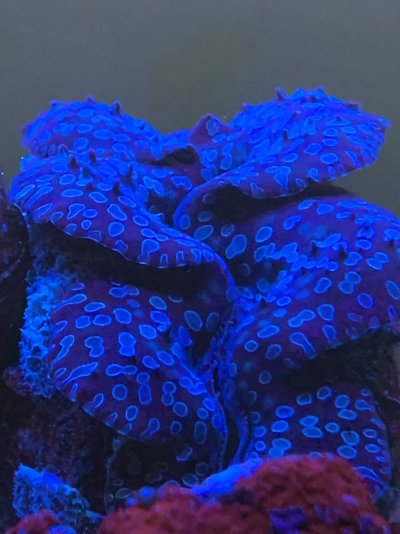There are T. noae that does not have the classic teardrop, which are spots with lighter borders. The ones that I have one have classic teardrops and colored rather than tan and brown. The blue one have drops that is not classic tear drops but it is blue in color.
The old name Tridacna elongata described in the 1819 really described T. noae rather than T. maxima. If one look at the shell shape and the flutes, there is no mistaken between Maxima vs Noae. Noae are much more elongated.
Noae was described as a species before Maxima (under a different name), then lumped together with Maxima and lost its species status. Now with genetic testing, they regain their species status. I think T. noae and T. maxima are different enough genetically that they don’t hybridized. There are variation in various population of T. noae but close enough that they still consider one species.
The classic teardrop Noae were first imported to the US from VietNam in the early 2000. I imported a box back in 2002 or so. I still have a picture of some of these clams somewhere. I gave these clams to some reefers in South Texas at the time(friend of mine). And sell some at cost to other reefers. It was a fun time.
When I see these clams, I am sure they are T. noae instead of T. maxima. Because of this reason I go ahead and ordered two. I am glad I did.
The old name Tridacna elongata described in the 1819 really described T. noae rather than T. maxima. If one look at the shell shape and the flutes, there is no mistaken between Maxima vs Noae. Noae are much more elongated.
Noae was described as a species before Maxima (under a different name), then lumped together with Maxima and lost its species status. Now with genetic testing, they regain their species status. I think T. noae and T. maxima are different enough genetically that they don’t hybridized. There are variation in various population of T. noae but close enough that they still consider one species.
The classic teardrop Noae were first imported to the US from VietNam in the early 2000. I imported a box back in 2002 or so. I still have a picture of some of these clams somewhere. I gave these clams to some reefers in South Texas at the time(friend of mine). And sell some at cost to other reefers. It was a fun time.
When I see these clams, I am sure they are T. noae instead of T. maxima. Because of this reason I go ahead and ordered two. I am glad I did.




















